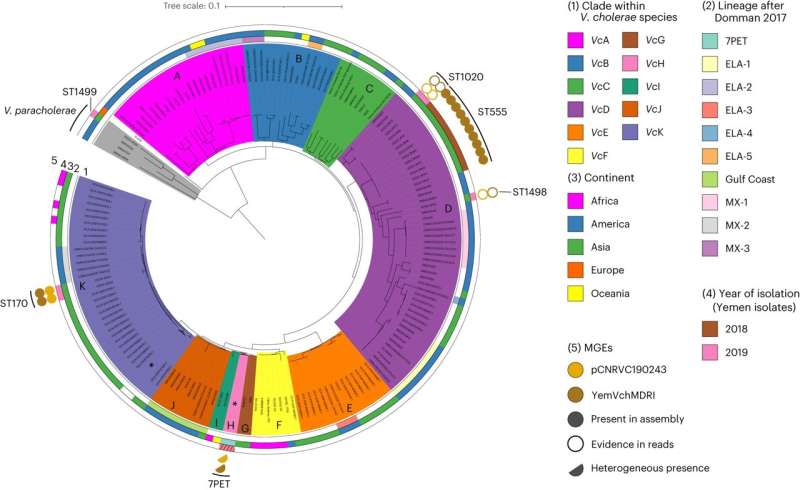This article has been reviewed according to Science X's editorial process and policies. Editors have highlighted the following attributes while ensuring the content's credibility:
fact-checked
peer-reviewed publication
trusted source
proofread
Widespread antibiotic resistance among cholera-causing bacteria explained by gene mixing

Scientists have identified the source of antibiotic resistance that emerged within bacteria driving the ongoing Yemen cholera epidemic.
The findings, published in Nature Microbiology, underscore the importance of ongoing genomic surveillance of pathogens to monitor the emergence of multidrug-resistant strains.
The cholera outbreak in Yemen is the largest in modern history, responsible for more than 2.5 million cases and at least 4,000 deaths since 2016. Cholera is an infectious disease caused by certain strains—genetic types—of bacteria known as Vibrio cholerae (V. cholerae) with epidemic potential.
Antibiotics help shorten the disease's duration, meaning the patient is less likely to have severe outcomes and remains transmissible for less time, reducing the potential for spread to others. Macrolides, a class of antibiotics, were widely used in Yemen until early 2019 to treat moderate to severe cases of cholera in pregnant women and children, who represented a significant number of cases.
However starting in 2018, health care professionals observed a troubling trend: patients were no longer responding to these frontline antibiotic treatments.
In this new study, researchers from the Wellcome Sanger Institute, University of Toronto, Institut Pasteur, Sana'a University and their collaborators set out to uncover the reasons behind this growing drug resistance, analyzing 260 epidemic V. cholerae DNA samples collected in Yemen between 2016 and 2019.
The team found that a type of V. cholerae containing multidrug-resistant genetic elements took over as the main pathogen during the Yemen outbreak period, likely from the widespread use of antibiotics at the time.
They identified the presence of a new plasmid—a small, circular DNA molecule—in all epidemic V. cholerae samples tested since November 2018. This plasmid introduced genes encoding resistance to multiple clinically used antibiotics, including macrolides.
The researchers also found the multidrug-resistant plasmid in local, endemic V. cholerae strains not associated with the cholera disease itself, suggesting these different strains were able to exchange plasmids with antibiotic-resistance capabilities. The strong selective pressure created by extensive antibiotic use at the time drove this process, they add.
The plasmid's stability in V. cholerae defies usual mechanisms that would have eliminated it. This resilience makes the strain a concerning factor in the context of future cholera outbreaks.
"This type of cholera pathogen was already highly successful before 2019, causing the largest cholera outbreak in recorded history. Now it has revealed how adaptable it is in the face of drug selection. What we have shown is the unexpectedly stable emergence of a new kind of cholera pathogen that combines the disease-causing tools of the one epidemic strain with the staying-power tools of others," says Dr. Florent Lassalle, first author of the study at the Wellcome Sanger Institute.
"This situation calls for more research into the evolution of bacterial genomes. With a better understanding of how V. cholerae evolves and its ability to drive disease outbreaks, we can improve strategies to fight it."
"This cholera strain, which has also been found in the Southeast African region, has the ability to pick up plasmids carrying multidrug resistance. This unexpected behavior poses a new threat for cholera control, and needs to be fully understood before we can develop effective mitigation strategies," adds Professor François-Xavier Weill and Dr. Marie-Laure Quilici, senior authors of the study at the Institut Pasteur, Paris.
"The ongoing global spread of this resilient cholera strain is deeply concerning. Conducting this study was particularly challenging due to the ongoing conflict in Yemen. Nevertheless, this was a collaborative effort involving multiple institutions across various countries, aimed at uncovering the underlying causes of cholera," says Dr. Abdul-Elah Al-Harazi, director of the National Center of the Public Health Laboratories, Yemen.
"The ultimate measure of our study's success, beyond the critical observations we have collectively made, lies in making our collective expertise, processes, and knowledge accessible to those who need it most. This was demonstrated in our recent symposium, uniting those from all over the world to accelerate our response against infectious diseases."
"This remains our shared objective, one that requires even more concerted efforts to achieve. It is clear from our findings that without more accurate data, this pathogen is unlikely to be eradicated anytime soon. However, with better data, we can instigate fundamental changes that will significantly improve public health on the ground."
More information: Florent Lassalle et al, Genomic epidemiology reveals multidrug resistant plasmid spread between Vibrio cholerae lineages in Yemen, Nature Microbiology (2023). DOI: 10.1038/s41564-023-01472-1
Journal information: Nature Microbiology
Provided by Wellcome Trust Sanger Institute


















